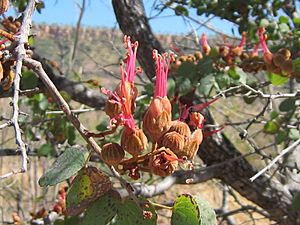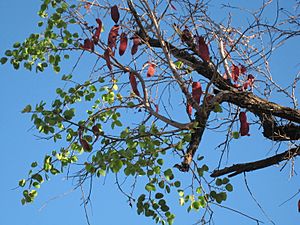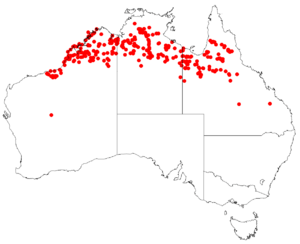Lysiphyllum cunninghamii facts for kids
Quick facts for kids Lysiphyllum cunninghamii |
|
|---|---|
 |
|
 |
|
| Conservation status | |
| Scientific classification | |
| Kingdom: | |
| (unranked): | |
| (unranked): | |
| (unranked): | |
| Order: | |
| Family: | |
| Subfamily: |
Cercidoideae
|
| Tribe: |
Bauhinieae
|
| Genus: |
Lysiphyllum
|
| Species: |
L. cunninghamii
|
| Binomial name | |
| Lysiphyllum cunninghamii (Benth.) de Wit
|
|
 |
|
| Occurrence data from AVH | |
| Synonyms | |
The Lysiphyllum cunninghamii is a special plant known as the Kimberley Bauhinia or the Jigal Tree. It belongs to the Fabaceae family, which includes peas and beans. This plant grows naturally in northern Australia, from Western Australia across the Northern Territory to Queensland.
Contents
About the Kimberley Bauhinia
What's in a Name?
The second part of the plant's scientific name, cunninghamii, honors Allan Cunningham. He was a botanist who explored with Phillip Parker King on the ship HMS Mermaid in 1820. Cunningham was the first to collect a sample of this plant.
The name Jigal comes from an Aboriginal word meaning "mother-in-law." This name refers to the plant's unique leaves. They have two parts that turn away from each other, much like how a mother-in-law and son-in-law might avoid facing each other in some Aboriginal traditions.
Aboriginal Names
This plant has many names in different Aboriginal languages:
- Jaminjung, Ngaliwurru, Nungali: Wanyarri (Ngal, Nung), Wayili (Jam)
- Jaru: gunji
- Mangarrayi language, Yangman: Gamulumulu (Mang, Yang)
- Miriwoong: Wanyarring
- Ngarinyman: Wanyarri
- Wagiman: windinyin
How to Spot It
The Kimberley Bauhinia can grow as a shrub or a tree. It can reach up to 12 meters tall, and sometimes even 18 meters! It has grey bark that often looks cracked or like a puzzle.
Its bright red flowers bloom from April to October. These flowers grow on older branches. After the flowers, large, reddish-brown seed pods appear from November to January. The sweet liquid (nectar) in the flowers is a favorite food for honeyeater birds and native bees.
During the dry season, these trees drop their leaves. But new leaves often start to grow just before the rainy season begins. The leaves are very special because they look like two butterfly wings joined together.
Where It Grows
You can find the Kimberley Bauhinia in places with red, sandy, or loamy soils. It often grows near watercourses, on riverbanks (levees), and in flood plains. It also thrives in areas called pindan and at the edges of monsoonal forests.
It is found across several IBRA bioregions. These include the Central Kimberley, Dampierland, Gascoyne, Great Sandy Desert, Northern Kimberley, Ord Victoria Plain, Pilbara, Victoria Bonaparte, and Katherine Region.
A Little About Its History
The Kimberley Bauhinia has had a few different scientific names over time! It was first described in 1852 by George Bentham. He called it Phanera cunninghamii. The very first sample of this plant was collected by Allan Cunningham in 1820 in the Kimberley region.
Later, in 1864, Bentham moved it to a different group, the Bauhinia genus, so it became Bauhinia cunninghamii. Finally, in 1956, a scientist named Hendrik de Wit decided it belonged in the Lysiphyllum genus. That's how it got its current scientific name, Lysiphyllum cunninghamii.
Amazing Uses
The leaves and pods of the Kimberley Bauhinia are full of protein and minerals. This makes them a good food source for farm animals. The tree's thick, drooping branches also provide great shade. Wallabies and other animals often rest under these trees to escape the hot sun.
The wood from this tree burns without much smoke, so it's often used for cooking fires. People also use the branches to create windbreaks, which help protect areas from strong winds.
Aboriginal people have many traditional uses for this plant. They would suck the sweet nectar directly from the flowers. They also made special liquids from the roots and inner bark. These liquids were used on the skin to help with cuts or as a general treatment for fevers and other illnesses. Another interesting use is mixing the sap with nectar to create a tasty, chewy gum, sometimes called "Turkish delight."


